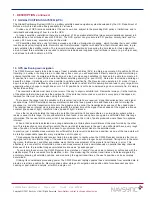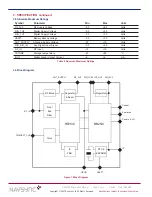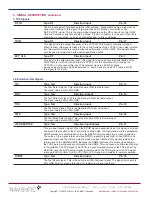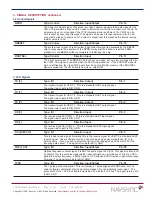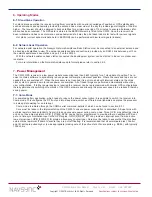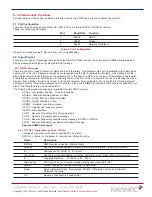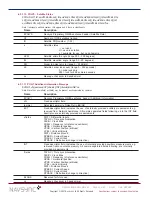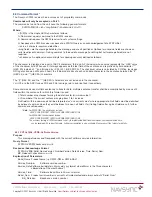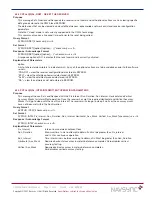
Copyright ©2007 NavSync Ltd.All Rights Reserved
Specifications subject to change without notice.
CW25 Software User Manual
Page
15 of 50
Rev 03
Date: 06/16/08
5. Features
5.1 Power on Reset
The power on reset for the CW25 is generated on-board by the regulator in the RF section from the RF_3V3 signal. The
RF_3V3 signal must be applied to the CW25 at the same time as the DIG_3V3, if the on-board power on reset is to be
used. If an external source of reset is to be applied to the NPOR signal after both the RF_3V3 and the DIG_3V3 signals are
valid, this restriction does not apply.
5.2 Time Transfer
In order to aid time transfer between fixes during which the CW25 has been unable to maintain an accurate perception of
time (eg. In deep sleep or powered down states), the on-board RTC can be set to provide a signal derived from the
32.768Hz crystal.
5.3
CW25 Embedded Identification
The hardware version number is hard coded onto the CW25; firmware also contains a version number allowing for easy
identification of the hardware and software version in embedded applications.
5.4
Build Options
There are two versions of the CW25 available:
CW25-NAV: This is the general navigation version of the CW25 GPS Receiver. It includes Network Assistance, which al-
lows the receiver to be sent ephemeris data from a base-station (such as the CW55) over a communications link, which
allow the receiver to acquire initial positional lock in harsh environments, down to signal levels of –185dBW (–155dBm).
CW25-TIM: This version of the CW25 has position-hold software included, which allows for very stable output frequency
control for timing applications. CW25-TIM has network assistance and stand - alone operation also. See specification in
Section 2.1
These two options have same physical characteristics and most features have no difference. They are two options with
different software programming included. The table below details the differences.
Options
GPIO [0]/PWM_OUT
1
Dynamics
2
$PRTHS Commands
6
CW25-NAV
Defaults to 0 MHz (disabled),
Default is 3.
VERS, DYNA, ITIM, RSET, INTM,
20 MHz (maximum). Output
Maximum is 5.
FRQD, UxOP, UxCM
enabled when frequency error
below 10 ppb.
CW25-TIM
Defaults to 10 MHz,
Default is 1; change to 0
VERS, DYNA, ITTM, RSET, INTM.
30 MHz maximum.
after 10-minute location
FRQD, UxOP, UxCM
Output always enabled.
survey completed.
Receiver must be and
remain stationary.
Table 5 Differences between CW25-NAV and CW25 TIM software
Notes
1. Refer to Section 8.3.10 and Section 13
2. Refer to Section 8.3.6 to see how to set PRTH<Q|S|R>, DYNA Command.





